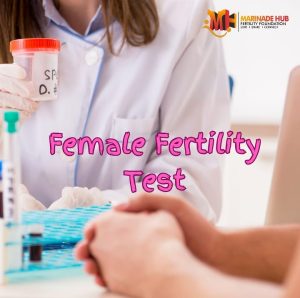
Assessing female fertility typically involves a combination of medical history analysis,physical examinations, hormone tests, ovarian reserve testing, and imaging studies. Here are some common tests used to evaluate female fertility:
1. Medical History and Physical Examination:
A thorough medical history helps identify any underlying health issues or lifestyle factors that
may affect fertility.A physical examination may include a pelvic exam to check for abnormalities in thier productive organs.
2. Hormone Tests:
● Follicle-Stimulating Hormone (FSH): Elevated FSH levels may indicate diminished ovarian reserve and reduced egg quality.
● Luteinizing Hormone (LH): Elevated levels can be associated with ovulatory disorders.
● Estradiol (E2): Elevated levels of estradiol can interfere with accurate FSH measurement, so it is often measured alongside FSH.
● Anti-Müllerian Hormone (AMH): Reflects ovarian reserve and can help predict the number of eggs remaining in the ovaries.
3. Ovulatory Function Tests:
● Progesterone Test: Done during the second half of the menstrual cycle to confirm ovulation.
● Basal Body Temperature (BBT) Charting: Monitoring changes in body temperature to identify the basal body temperature rise associated with ovulation.
Read also: https://marinadehub.org/understanding-why-women-should-consider-fertility-testing/
4. Ovarian Reserve Testing:
● Antral Follicle Count (AFC): Assesses the number of small follicles in the ovaries using ultrasound.
● Ovarian Volume Measurement: Measures the size of the ovaries, which can provide additional information about ovarian reserve.
5. Imaging Studies:
● Transvaginal Ultrasound: Allows visualization of the uterus, Fallopian tubes, and ovaries to detect abnormalities.
● Hysterosalpingography (HSG): An X-ray procedure to evaluate the shape of the uterus and check for blockages in the fallopian tubes.
● Sonohysterography: Involves injecting sterile saline into the uterus during ultrasound to assess the uterine cavity.
● Genetic Testing for Specific Conditions: Depending on family history, testing for conditions like Fragile X syndrome or Thalassemia might be considered.
6. Hysteroscopy and Laparoscopy:
● Hysteroscopy: A procedure using a thin, lighted tube to examine the inside of the uterus.
● Laparoscopy: A minimally invasive surgery to inspect the pelvic organs, often used to
identify and treat conditions like endometriosis or pelvic adhesions.
Which of these tests are actually new to you? Let us know in the comment section ????
#FertilityTests #FertilityWellness #TTcJourney

